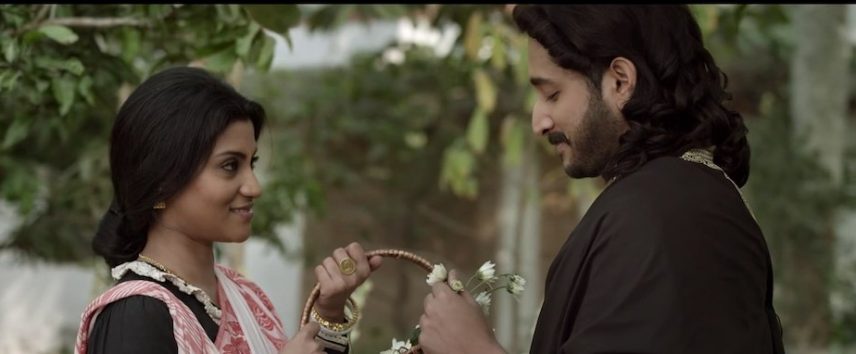
"Tomarei kariachi jibaner dhrubatara
A samudre ar kabhu habo nako pathahara..."
(I have made you my life's cynosure
Ne'er again shall I be lost in this ocean.")
This song, written by Bengal's Nobel Prize winning poet Rabindranath Tagore, was published in 1880 in his collection of poems titled 'Bhagno-hridoy' when he was just 19 years of age. In this book, for the first time a page for dedication was included and this song was used. The page indicated that the book was dedicated to 'Mrs. Hey...'. Lots of research has been done to decipher the code name. The name of the main witch in the Macbeth is Heckety. It was later known that Rabindranath used to call his sister-in-law, Kadambari Devi, this name in order to ridicule her. Researchers now are almost certain that this 'Mrs. Hey...' is nobody else but Kadambari. Director Suman Ghosh's film "Kadambari", based on the life of Kadambari Devi, ends with this song.
The film "Kadambari", based on Sunil Gangopadhyay's "Prothom Alo", Mallika Sengupta's "Kobir Bouthan" and the writings of Rabindranath Tagore, scans the life of Kadambari Devi from the time she entered the Tagore household as a young bride till she committed suicide. Kadambari Devi's suicide is one of the sensational events in the cultural history of Bengal. Rabindranath Tagore was particularly fond of this sister-in-law of his. The film explores their relationship and the lives of the women of Tagore household of that time.
Kadambari Devi was the wife of Jyotirindranath Tagore and daughter-in-law of Debendranath Tagore. She was almost a decade younger than her husband, whom she married on 5th July, 1868, (the 25th day of the Bengali month Ashar, the year being 1275 according to the Bengali calender) at the tender age of ten years. It was customary for girls of that time to get married early, Kadambari being no exception. Being the daughter-in-law of the illustrated Tagore household, she had certain privileges, like getting educated or riding horse, unlike other women of her generation.
Kadambari Devi was the daughter of the accountant of the Tagore household. That's why other women of the household, especially Jnanadanandini Devi, wife of Satyendranath Tagore, resented her being the daughter-in-law of the Tagore household and looked down on her. Early in her marriage, she had to accept the hard truth that she would never be able to become the 'Ghorer Bou' of Tagore household.
Rabindranath Tagore, her brother-in-law, was almost of her age. So while Jyotirindranath was busy with his literary nuances, theatre and other hobbies such as ship business and some other business ventures, her only confidante in her humongous matrimonial palace became Robi. Robi too found the biggest critique and greatest admirer of his literary endeavours in his Notun Bouthan. This friendship that blossomed between two persons of same age can't be termed as love, yet Kadambari found an emotional anchorage in this friendship, especially given the almost non-existent role of her husband in her life.
Kadambari failed to bear any children from her marriage and was taunted as 'banja' (the Bengali synonym used for childless women) by other women of the household. She found solace in a little girl Urmila, daughter of her sister-in-law. Urmila had an untimely death. She fell down from the staircase while Kadambari was asleep. Everyone in the family accused Kadambari's negligence for Urmila's death.
Meanwhile, Kadambari's growing intimacy with Rabindranath irked other members of the Tagore family. They hastily arranged the marriage of Rabindranath Tagore, which made Kadambari further lonely. She at that time desperately sought the much-needed solace from her husband, who was supposed to be her partner for life. But at this crucial junction of life, she came to know of the existence of another woman in her philanderer husband's life, which ultimately propelled her to take her own life on 19th April, 1884, just four months after the poet's marriage with Mrinalini Debi.
What prompted Kadambari to end her life prematurely, at the tender age of twenty-six? Twenty-six is by no means a dieable age. Was she seeking something more than friendship from her childhood playmate Rabindranath Tagore? Was this friendship bordering on the fringes of love? Or was it the inability to conceive a child? A child could have perhaps saved her loveless marriage with Jyotirindranath. She didn't leave any suicide note behind, so we can only speculate about the probable cause of her death. Or was it all these factors together that took a toll on her? Intrigued by the movie, when I searched the web to know more of this woman, the sepia coloured portrait that came up somehow gave me the impression of a lonely, bereft woman.
Kadambari's life serves as a reminder how far we have come from that era when women didn't have any identity apart from being someone's wife or someone's mother. It reminds us of the struggle our foremothers had gone through. A dysfunctional, childless marriage spoiled a woman's life who could have had a brilliant literary career had she been born in another era. We are fortunate to live in an era where we can think of a life outside marriage and kids. This movie reaffirms this fact and that's why it's a must-watch for all.
This post titled "Why The Movie Kadambari Made Me Appreciate My Freedom Just A Little More" has been published on Women's Web as a Featured Post. Featured Posts are a careful selection of highly relevant and interesting posts picked up by the editor's of Women's Web each day. To read the full story, Click here.
